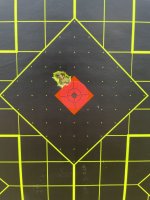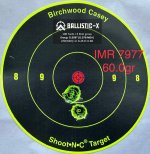We're not doing this here. Take it to DM's if you 2 want to discuss if further. Or start your own thread about it so you can stop fucking up other people's threads.The OSHA 140db threshold that gets brought up all the time is a single exposure in 24 hours. Even 120 db can damage your hearing. Further, none of these numbers are absolute and your hearing can be damaged with lower DB sound pressures. As you said, suppressed super sonic center fire rifles are not hearing safe.
Join the Hide community
Get access to live stream, lessons, the post exchange, and chat with other snipers.
Register
Download Gravity Ballistics
Get help to accurately calculate and scope your sniper rifle using real shooting data.

Install the app
How to install the app on iOS
Follow along with the video below to see how to install our site as a web app on your home screen.
Note: This feature may not be available in some browsers.
You are using an out of date browser. It may not display this or other websites correctly.
You should upgrade or use an alternative browser.
You should upgrade or use an alternative browser.
Suppressors *** NEW *** Otter Creek Labs Hydrogen L & S .30 caliber Suppressors
- Thread starter FuhQ
- Start date
We're not doing this here. Take it to DM's if you 2 want to discuss if further. Or start your own thread about it so you can stop fucking up other people's threads.
The discussion is relevant to your topic. Other posters brought it up and you seemed happy to discuss it until it was pointed out you were wrong.
I don’t care if you think I’m wrong, or if it’s relevant to suppressors in general. I don’t want my thread destroyed by that bullshit drivel.The discussion is relevant to your topic. Other posters brought it up and you seemed happy to discuss it until it was pointed out you were wrong.
Every GD suppressor thread turns into this, and it dies not long after, because everybody is sick of hearing you drone on about it. I’m not having that shit here.
You'd have to define "hearing safe."
Another way to say it is that every cartridge you shoot out of a gun, regardless of what's hanging off the muzzle, represents some level of risk to your hearing. You can make that risk very low: 22 subsonic suppressed, hollywood quiet. You can make it slightly higher - 22 supersonic suppressed. The sonic boom shockwave is propagating away from you and isn't inducing a big impulse to your ear. A .177 springer pellet gun can go supersonic yet remain very comfortable. Certainly for a single shot a day, for example - if you've shot one you know what I mean.
Pew Science is a dosimeter that helps to determine that level of risk. A shot or two on a hunt through a 22" Creedmoor with a Hyperion, is lower risk to the shooter placed back behind the rifle than a shot or two through a full sized Rugged Oculus 22lr can on a Beretta Bobcat, with its semi-auto action and that close to the shooter. I would call those Creedmoor shots hearing safe.
The sonic crack of a .30 cal bullet is louder than the sonic crack of a .177 pellet. Yes, a single shot through a suppressor is lower risk than an unmuffled gunshot from the same rifle but that statement assumes you're only ever going to shoot one shot. If you intend to only use the silencer without hearing protection while hunting it is a different conversation. Most users aren't simply using the silencer to shoot one round during hunting season, they're using them all the time. The problem is that hearing is a complicated subject and most people hear "hearing safe" and stop using hearing protection all together.
I will say after using my Hydrogen L extensively, It's an amazing can for the weight. It makes my 284 win hearing safe and only made it to where I had to come up 2 tenths to re-zero. It hammers out consistent .25 moa groups with no issues. I have shot it and some TBAC cans at local PRS matches, and the OCL out preforms the respective TBAC can in sound, recoil, and every other metric. I plan on picking up more and more OCL products and will fully recommend them to anyone looking for great suppressors.
Staying on topic: here's a short list of subsonic host/can combinations that are louder to the shooter than the Hydrogen-L, with the Ultra 9 on 20" 308 thrown in for good measure.

What the rating number means:
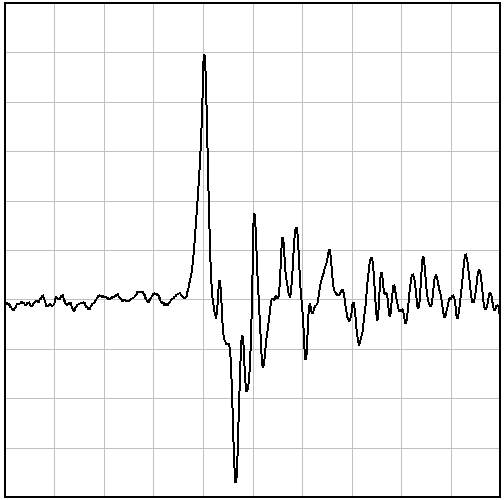
 pewscience.com
pewscience.com
None of these are good for a full day at the range. All of these are good for a mag a day. No meaningless Osha once daily 140db nonsense here. I don't even understand what there is to argue about sound anymore when Pew Science exists.
What the rating number means:

SSS.5 - Suppression Rating™ — PEW Science
The most accurate silencer sound testing decibel chart for hearing safe determinations for firearm suppressors. PEW-SOFT is the most accurate decibel meter available.
None of these are good for a full day at the range. All of these are good for a mag a day. No meaningless Osha once daily 140db nonsense here. I don't even understand what there is to argue about sound anymore when Pew Science exists.
I don't even understand what there is to argue about sound anymore when Pew Science exists.
Pew Science is someone's opinion. The metric Jay uses is proprietary and unverifiable by third parties.
Not even by Jays metrics are any of the center-fire suppressors even close to being hearing safe.Pew Science is someone's opinion. The metric Jay uses is proprietary and unverifiable by third parties.
His arbitrary metric has 'truly hearing safe' at just over 90 points. No can is even close to that in his own rankings.
Not even by Jays metrics are any of the center-fire suppressors even close to being hearing safe.
His arbitrary metric has 'truly hearing safe' at just over 90 points. No can is even close to that in his own rankings.
True
What I actually said:
"None of these are good for a full day at the range. All of these are good for a mag a day."
If we just keep moving the goal posts of "hearing safe" around to exclude hunting, limited practice, etc we can keep our collective understanding stuck in 2019 forever. I think I understand FuhQ's frustration with the topic now. Good luck everyone.
"None of these are good for a full day at the range. All of these are good for a mag a day."
If we just keep moving the goal posts of "hearing safe" around to exclude hunting, limited practice, etc we can keep our collective understanding stuck in 2019 forever. I think I understand FuhQ's frustration with the topic now. Good luck everyone.
What I actually said:
"None of these are good for a full day at the range. All of these are good for a mag a day."
If we just keep moving the goal posts of "hearing safe" around to exclude hunting, limited practice, etc we can keep our collective understanding stuck in 2019 forever. I think I understand FuhQ's frustration with the topic now. Good luck everyone.
I don't think the collective understanding of human hearing is even up to 2019. FukQ is frustrated because he made false statements and was called out for them. There isn't a black and white line where one decibel rating is safe and another isn't. You can damage your hearing with 80db exposure, it depends on duration and how often you're exposed to the sound. The goal post naturally moves because hearing and hearing damage are not absolute thresholds.
I don't think the collective understanding of human hearing is even up to 2019. FukQ is frustrated because he made false statements and was called out for them. There isn't a black and white line where one decibel rating is safe and another isn't. You can damage your hearing with 80db exposure, it depends on duration and how often you're exposed to the sound. The goal post naturally moves because hearing and hearing damage are not absolute thresholds.
And the best way to avoid permanent hearing damage is to wear hearing pro even with suppressors, regardless of how many points a suppressor got on an arbitrary metric.
A few things:
1) The 140dB number is bogus. Just stop it, unless you're willing to die on a hill that was built by OSHA more than 50 years ago.
2) All of this is dependent upon the dose. Jay's metrics appear to take this into account, but unfortunately there's a lot of voodoo that goes between his raw data and his final score. The AHAAH approach is flawed (as the TBAC guys have accurately pointed out) but at least it's open-source and absolute in nature (you're given a daily dose limit and each shot subtracts from that total daily dose).
3) There's the matter of how much damage is acceptable to any individual. AHAAH uses a temporary threshold shift (TTS) of 25 dB as acceptable. Grandpa who's hunted with his unsuppressed .30-06 for 50 years presumably accepts a bigger TTS because he's "not a pussy". An audio engineer would likely find this unacceptable.
4) The sonic crack is part of the signature and thus contributes to the total dose, so it shouldn't be neglected. But it takes pretty damn good suppressor performance to make this a meaningful part of the dose. It might be non-trivial if you're blasting all day with a Magnus on a 26" 6GT, but I really doubt it's much of a factor with a K can on a Mk18.
I'll admit that I often go without earpro when shooting suppressed rimfires, or short strings of centerfire pistol, or a handful of shots from a centerfire rifle. All of these are likely causing a TTP, but I find this to be an acceptable risk. I'm usually doing this at my home range, which doesn't have any walls or overhead cover; introduce those elements and I'm scrambling to find some plugs or muffs. And my kids don't get to play by the same rules, because I'm a hypocrite.
1) The 140dB number is bogus. Just stop it, unless you're willing to die on a hill that was built by OSHA more than 50 years ago.
2) All of this is dependent upon the dose. Jay's metrics appear to take this into account, but unfortunately there's a lot of voodoo that goes between his raw data and his final score. The AHAAH approach is flawed (as the TBAC guys have accurately pointed out) but at least it's open-source and absolute in nature (you're given a daily dose limit and each shot subtracts from that total daily dose).
3) There's the matter of how much damage is acceptable to any individual. AHAAH uses a temporary threshold shift (TTS) of 25 dB as acceptable. Grandpa who's hunted with his unsuppressed .30-06 for 50 years presumably accepts a bigger TTS because he's "not a pussy". An audio engineer would likely find this unacceptable.
4) The sonic crack is part of the signature and thus contributes to the total dose, so it shouldn't be neglected. But it takes pretty damn good suppressor performance to make this a meaningful part of the dose. It might be non-trivial if you're blasting all day with a Magnus on a 26" 6GT, but I really doubt it's much of a factor with a K can on a Mk18.
I'll admit that I often go without earpro when shooting suppressed rimfires, or short strings of centerfire pistol, or a handful of shots from a centerfire rifle. All of these are likely causing a TTP, but I find this to be an acceptable risk. I'm usually doing this at my home range, which doesn't have any walls or overhead cover; introduce those elements and I'm scrambling to find some plugs or muffs. And my kids don't get to play by the same rules, because I'm a hypocrite.
No, I'm frustrated because I honestly don't give a shit if you're right or wrong. It's simply annoying, and I'm tired of hearing this bullshit in EVERY suppressor thread just so some pencil-neck can feel some sense or relevancy in life. Use ear pro or don't... Use at your own risk. We know...We know...We know...We know...We know!!!I don't think the collective understanding of human hearing is even up to 2019. FukQ is frustrated because he made false statements and was called out for them. There isn't a black and white line where one decibel rating is safe and another isn't. You can damage your hearing with 80db exposure, it depends on duration and how often you're exposed to the sound. The goal post naturally moves because hearing and hearing damage are not absolute thresholds.
Last edited:
140db is useless but raw dB collected in a barn is science. Dosimeters are great and what we need instead, but vaporware AHAHA means more than the obvious industry standard that exists and is anecdotally validated every day. Industry sure is quiet about disputing its results. The silence is deafening, but is it hearing safe? Hearing safety is only achievable by not shooting, or shooting with earpro and cans, hunting isn't shooting, only sonic booms matter, supers can't be quieter than subs. I think I'm tracking so far... ah, yes, it's literally 2019.
All this and people still wonder why the Form 1 guys are walking all over the big dogs.
All this and people still wonder why the Form 1 guys are walking all over the big dogs.
No, I'm frustrated because I honestly don't give a shit if you're right or wrong. It's simply annoying, and I'm tired of hearing this bullshit in EVERY suppressor thread just so some pencil-neck can feel some sense or relevancy in life. Use ear pro or don't... Use at your own risk. We know...We know...We know...We know...We know!!!
You care.
You greatly overestimate the importance of your opinion…As well as my level of give a shit about other peoples opinions, or what other people do. The fact is, people are going to “people” no matter what, so might as well stop minding their business. Most folks never figure that out. The ones that do, live a much more peaceful life.You care.
For example, I know my opinion means absolutely jack shit, unless someone thinks it’s worth something to them personally. That’s why I don’t go around forcing it on people. I can try to steer people into a correct direction, but at the end of the day, it’s their money (or hearing), and they’re gonna do whatever their gonna do.
Last edited:
I would like a real industry standard. Open and up for peer review that includes some sort of risk assessment number
Agreed.I would like a real industry standard. Open and up for peer review that includes some sort of risk assessment number
Before Pew Science, peak dB was the only standard. There was zero discussion of risk assessment, certainly not to consumers armed with OSHA alone.
In the Pew Science review of the Ultra 9 that was publicized nearly two years ago now, there are no fewer than 15 peak dB numbers listed, open for peer review. There are no fewer than 7 waveforms for the first round alone, also open for peer review. These inputs form the output for the proprietary rating.
Have you peer reviewed these inputs and found them to be inaccurate?
In the Pew Science review of the Ultra 9 that was publicized nearly two years ago now, there are no fewer than 15 peak dB numbers listed, open for peer review. There are no fewer than 7 waveforms for the first round alone, also open for peer review. These inputs form the output for the proprietary rating.
Have you peer reviewed these inputs and found them to be inaccurate?
I would like a real industry standard. Open and up for peer review that includes some sort of risk assessment number
Strongly in agreement, Ray
Before Pew Science, peak dB was the only standard. There was zero discussion of risk assessment, certainly not to consumers armed with OSHA alone.
In the Pew Science review of the Ultra 9 that was publicized nearly two years ago now, there are no fewer than 15 peak dB numbers listed, open for peer review. There are no fewer than 7 waveforms for the first round alone, also open for peer review. These inputs form the output for the proprietary rating.
Have you peer reviewed these inputs and found them to be inaccurate?
It's great that Jay is publishing what he does and providing a free education on suppressor performance (his podcast is somewhat difficult to listen to, but chuck full of great info so I grind my teeth and ensure).
That being said, as a fellow engineer who performs a variety of standardized testing to ensure that my junk works as intended, I find the obvious following deficiencies:
1) He has not published a list of equipment, settings/configurations, and calibration certs. I can guess at his transducer and data acq, but cannot knowingly clone it. I'm sure this is intentional.
2) He does not offer a file with the data points in a human- or machine-readable format (be it tabular or as a WAV), which prevents me from applying alternative analytical techniques which may be valid ways to interpret the results.
3) The algorithm used to go from raw data to an overall rating remains a black box. He has not offered his "inner ear model" for peer review or provided any justification for acceptable total dose, so users do not know if his limit criteria meet their own expectations.
3) His Suppression Rating score is highly subjective; i.e. "limited hunting engagement", "high volume fire", etc. Compare this to the AHAAH method of providing an objective dose and dose limit.
4) He regularly admits to withholding test results. The reasons for this are subject to assumptions that may or may not be fair to PEW Science, but it doesn't take long to form one or more hypotheses that suggest an attempt to swing the market in a direction that is favorable to the guy who has an exclusive test method and charges substantial money to access it.
In short, his results cannot be verified or reproduced, and because he takes money from test clients and also takes money from consumers to access the data, there is at least the appearance of providing favorable publicity and "gatekeeping" in exchange for monetary considerations. I couldn't get a master's degree or obtain customer acceptance of my results by occluding the test methods and raw data listed above. Jay is a good enough engineer and businessman to know all of this as well.
This isn't intended to blast Jay (I'm sure it will come off harsher than I intend), but I'm getting a bit tired of Internet randos holding him up as a deity and his conclusions as some sort of silencer Bible.
1/2. I understand any consumer's categorical misgivings about a proprietary rating. That's why I asked specifically about the raw data. Help me to understand: when I ask whether Jay's peak dBs and waveforms published are inaccurate, are you saying that such waveforms and peaks are flat unknowable and unreproducible? Are you saying that it is actually impossible for anyone to capture waveforms and peak dBs like that for a few cans, overlay them with Jay's results, and thereby demonstrate how Jay's raw data is wrong?
I'm asking this seriously. Where is the public alternative pile of waveforms and peak dBs that I as a consumer could use to make comparisons with Jay's raw data, for example to highlight the relative deltas between peak dBs across several different cans?
3. Peak dB was the only standard prior to Pew Science. Peak dB remains the standard for certain can companies. It's been over two years, and alternative publicized and supported standards remain theoretical vaporware. I too would prefer an independent lab, publishing free and open source today, with transparent financing and no profit motive of any kind. Cool, who's gonna build that? Where is it? Could it be that the silencer industry at large remains more interested in marketing potential than transparency, and that's why we're still only talking about it in theory?
4. If Jay is bending the results and publication schedule to at worst benefit his favorite companies, or at best benefit his own company, would you mind pointing me in the direction of a free, open source, non-profit silencer company, whose conclusions can instead be held up as some sort of silencer bible rather than an obvious attempt to sell you one of their cans as per the entire previous history of metering in the silencer industry?
I'm asking this seriously. Where is the public alternative pile of waveforms and peak dBs that I as a consumer could use to make comparisons with Jay's raw data, for example to highlight the relative deltas between peak dBs across several different cans?
3. Peak dB was the only standard prior to Pew Science. Peak dB remains the standard for certain can companies. It's been over two years, and alternative publicized and supported standards remain theoretical vaporware. I too would prefer an independent lab, publishing free and open source today, with transparent financing and no profit motive of any kind. Cool, who's gonna build that? Where is it? Could it be that the silencer industry at large remains more interested in marketing potential than transparency, and that's why we're still only talking about it in theory?
4. If Jay is bending the results and publication schedule to at worst benefit his favorite companies, or at best benefit his own company, would you mind pointing me in the direction of a free, open source, non-profit silencer company, whose conclusions can instead be held up as some sort of silencer bible rather than an obvious attempt to sell you one of their cans as per the entire previous history of metering in the silencer industry?
In a bolt action or even semi with full power loads, focusing on sound suppression is beyond stupid
1st off a lot of the things they do to increase suppression (beyond straight volume) usually goes against accuracy
My main focus is accuracy, if the can is not accurate what’s the point ? First round pops that throw a flyer, inconsistent accuracy because they are throwing in a bunch of keys or something, lame
We are shooting full power loads and across my 36+ personally owned suppressors my ears still ring and if you are on the wrong side I didn’t understand what you said.
Only accuracy is interesting
1st off a lot of the things they do to increase suppression (beyond straight volume) usually goes against accuracy
My main focus is accuracy, if the can is not accurate what’s the point ? First round pops that throw a flyer, inconsistent accuracy because they are throwing in a bunch of keys or something, lame
We are shooting full power loads and across my 36+ personally owned suppressors my ears still ring and if you are on the wrong side I didn’t understand what you said.
Only accuracy is interesting
1/2. I understand any consumer's categorical misgivings about a proprietary rating. That's why I asked specifically about the raw data. Help me to understand: when I ask whether Jay's peak dBs and waveforms published are inaccurate, are you saying that such waveforms and peaks are flat unknowable and unreproducible? Are you saying that it is actually impossible for anyone to capture waveforms and peak dBs like that for a few cans, overlay them with Jay's results, and thereby demonstrate how Jay's raw data is wrong?
I'm asking this seriously. Where is the public alternative pile of waveforms and peak dBs that I as a consumer could use to make comparisons with Jay's raw data, for example to highlight the relative deltas between peak dBs across several different cans?
3. Peak dB was the only standard prior to Pew Science. Peak dB remains the standard for certain can companies. It's been over two years, and alternative publicized and supported standards remain theoretical vaporware. I too would prefer an independent lab, publishing free and open source today, with transparent financing and no profit motive of any kind. Cool, who's gonna build that? Where is it? Could it be that the silencer industry at large remains more interested in marketing potential than transparency, and that's why we're still only talking about it in theory?
4. If Jay is bending the results and publication schedule to at worst benefit his favorite companies, or at best benefit his own company, would you mind pointing me in the direction of a free, open source, non-profit silencer company, whose conclusions can instead be held up as some sort of silencer bible rather than an obvious attempt to sell you one of their cans as per the entire previous history of metering in the silencer industry?
It's a fundamental tenant of science and engineering that data be reproducible. I can't do validation testing for a client without reporting every detail, right down to equipment cal dates and environmental conditions. This skepticism is not personal or directed at Jay; it's simply what should be done anytime someone says "trust me". On his podcast, Jay constantly talks about the "pedigree" of his data as if it's an inherent property of a dataset. It isn't.
But that's simply a sideshow to the larger problem of proprietary algorithms being used to calculate the dose, proprietary limits being established for the total allowable daily dose, and selective publication of test results. If that's not immediately problematic for you, then I'm unlikely to change your mind with any additional posts.
Accuracy is definitely paramount, and only precise cans are interesting. I agree with all of this except the premise that because accuracy matters sound does not. Especially since my hearing is relatively intact and I want to keep it that way. That means knowing going in the risk I'm exposing myself to. As you just alluded to yourself - consistency in sound (FRP) can correlate with consistency in precision.In a bolt action or even semi with full power loads, focusing on sound suppression is beyond stupid
1st off a lot of the things they do to increase suppression (beyond straight volume) usually goes against accuracy
My main focus is accuracy, if the can is not accurate what’s the point ? First round pops that throw a flyer, inconsistent accuracy because they are throwing in a bunch of keys or something, lame
We are shooting full power loads and across my 36+ personally owned suppressors my ears still ring and if you are on the wrong side I didn’t understand what you said.
Only accuracy is interesting
I've watched your progression with various cans with interest, including running an OSS on a bolt action. Given all the things you just said, it makes perfect sense to me to do that, like avoiding backpressure almost entirely, lots of tapers and symmetry and concentricity, etc. Given that it would be useful to know the backpressure, right? In that case the Omega762 metric is your huckleberry. Backpressure quantified.
It doesn't hurt to know which cans do better or worse FRP-wise when you are looking for consistency, right? If you knew with certainty which cans performed the most consistently from shot to shot, you would take note of that wouldn't you? Because that's exactly what the sound testing for the KGM R30 shows, which the FBI happened to select for the precision role - not a coincidence. The waveforms graphically illustrate exactly that consistency and the FRP performance also highlights it. My point is that sound doesn't have to matter for sound testing to matter. This sound testing is directly related to precision for exactly the reasons you outlined.
Have you tried CGS cans, Hyperion for example? The large coaxial annular chamber and giant bore size might help alleviate some of the influences that happen to the bullet. It is a good FRP performer and like OSS (at least post-Flow), you get 3d-printed concentricity and tapers. I think it would be beyond awesome to be able to quantify the precision potential of a can. If such public testing existed I would also look first at that, and then sound second - but it doesn't. So here we are..
Last edited:
The dB numbers Jay posts are inline with the numbers we get. He posts unweighted and we post A weighted but the numbers line up. I haven't really looked at any of his wave forms I would expect them to be good too. Just like our dB numbers are very good and so are our wave forms.
As I've said in the past and is mentioned above we have no idea how the magic number is achieved. With a real standard anyone with the proper equipment could verify or call bullshit. I think some sorta number like AHAAH would be great. So how much time do we grab and how do we do the math. We have been nothing but open and transparent in what we post and want a true open for review standard.
Frank I want accurate and quiet. Magnus
As I've said in the past and is mentioned above we have no idea how the magic number is achieved. With a real standard anyone with the proper equipment could verify or call bullshit. I think some sorta number like AHAAH would be great. So how much time do we grab and how do we do the math. We have been nothing but open and transparent in what we post and want a true open for review standard.
Frank I want accurate and quiet. Magnus
The dB numbers Jay posts are inline with the numbers we get. He posts unweighted and we post A weighted but the numbers line up. I haven't really looked at any of his wave forms I would expect them to be good too. Just like our dB numbers are very good and so are our wave forms.
As I've said in the past and is mentioned above we have no idea how the magic number is achieved. With a real standard anyone with the proper equipment could verify or call bullshit. I think some sorta number like AHAAH would be great. So how much time do we grab and how do we do the math. We have been nothing but open and transparent in what we post and want a true open for review standard.
Frank I want accurate and quiet. Magnus
I love all the videos you guys post with your suppressor testing, keep it up!
And I think the next can in my stable is going to be a Magnus.
Agreed, on all points, Ray. Also, I’m after accurate and quiet.The dB numbers Jay posts are inline with the numbers we get. He posts unweighted and we post A weighted but the numbers line up. I haven't really looked at any of his wave forms I would expect them to be good too. Just like our dB numbers are very good and so are our wave forms.
As I've said in the past and is mentioned above we have no idea how the magic number is achieved. With a real standard anyone with the proper equipment could verify or call bullshit. I think some sorta number like AHAAH would be great. So how much time do we grab and how do we do the math. We have been nothing but open and transparent in what we post and want a true open for review standard.
Frank I want accurate and quiet. Magnus
Hope to add a Magnus HUB to my collection soon.
Ray confirms having reproduced the raw data. I believe it was Zak who said the waveforms lined up, a year or two back. I can largely achieve "good enough" results while using slightly different ovens and ingredients as the pictures in cooking recipes too. The type of validation you are narrowly referring to is test method validation. Call it verification or confirmation instead if you need to expand your definition to include what I was actually repeatedly referring to here.It's a fundamental tenant of science and engineering that data be reproducible. I can't do validation testing for a client without reporting every detail, right down to equipment cal dates and environmental conditions. This skepticism is not personal or directed at Jay; it's simply what should be done anytime someone says "trust me". On his podcast, Jay constantly talks about the "pedigree" of his data as if it's an inherent property of a dataset. It isn't.
But that's simply a sideshow to the larger problem of proprietary algorithms being used to calculate the dose, proprietary limits being established for the total allowable daily dose, and selective publication of test results. If that's not immediately problematic for you, then I'm unlikely to change your mind with any additional posts.
A pedigree has a provenance, and that relationship is and of itself an inherent property of a dataset. You may not like the provenance in question or agree that the pedigree is significant. But this shows why the accuracy of the raw data in not merely a sideshow, but a demonstration of competence and therefore credibility.
As I said from the jump: "I understand any consumer's categorical misgivings about a proprietary rating." But we can agree that the data is not whipped from thin air. So where does that leave Pew Science? At the very least, as the single most comprehensive and arguably authoritative (there's that pedigree again) single source on comparatively relevant raw dB numbers. Everyone measured this exact type of data against OSHA until the moment Pew arrived on the scene and changed the entire conversation to risk. "Pushing the industry forward."
Say an AHAAH implementation succeeds, and that it proliferates. Consider the very real possibility that it ends up correlating exactly with Pew's existing rankings. Pew Science will then at the very worst have sparked, or more accurately forced, a long overdue sea change in the silencer industry. Frankly as a consumer I'm not only willing to table my categorical skepticism for this purpose, it's completely rational for me to reserve at least as much skepticism for anyone whose entire incentive structure is to sell me a can. I wish TBAC and the rest the best of luck, and I enjoy the data that they put out as well - not to mention their products. I just won't pretend that this is about Jay hoodwinking everyone or that people buy 9" cans because sound isn't important.
I don’t think any current sound measuring and metering system is flawless, but I think Jay and @TBACRAY having similar results and numbers is a damn good start to creating a truly honest and unbiased standardized metering and measuring system. Something unbiased and no personal agenda.Ray confirms having reproduced the raw data. I believe it was Zak who said the waveforms lined up, a year or two back. I can largely achieve "good enough" results while using slightly different ovens and ingredients as the pictures in cooking recipes too. The type of validation you are narrowly referring to is test method validation. Call it verification or confirmation instead if you need to expand your definition to include what I was actually repeatedly referring to here.
A pedigree has a provenance, and that relationship is and of itself an inherent property of a dataset. You may not like the provenance in question or agree that the pedigree is significant. But this shows why the accuracy of the raw data in not merely a sideshow, but a demonstration of competence and therefore credibility.
As I said from the jump: "I understand any consumer's categorical misgivings about a proprietary rating." But we can agree that the data is not whipped from thin air. So where does that leave Pew Science? At the very least, as the single most comprehensive and arguably authoritative (there's that pedigree again) single source on comparatively relevant raw dB numbers. Everyone measured this exact type of data against OSHA until the moment Pew arrived on the scene and changed the entire conversation to risk. "Pushing the industry forward."
Say an AHAAH implementation succeeds, and that it proliferates. Consider the very real possibility that it ends up correlating exactly with Pew's existing rankings. Pew Science will then at the very worst have sparked, or more accurately forced, a long overdue sea change in the silencer industry. Frankly as a consumer I'm not only willing to table my categorical skepticism for this purpose, it's completely rational for me to reserve at least as much skepticism for anyone whose entire incentive structure is to sell me a can. I wish TBAC and the rest the best of luck, and I enjoy the data that they put out as well - not to mention their products. I just won't pretend that this is about Jay hoodwinking everyone or that people buy 9" cans because sound isn't important.
I would say that these Hydrogen Suppressors are insanely accurate. No perceivable first round pop to me. Using a Liberty bell muzzle brake and Rearden Atlas mount, my POI shift is none. This is a 15 round group at 100 yards with my 284 win using the hydrogen L. Cold bore is included.In a bolt action or even semi with full power loads, focusing on sound suppression is beyond stupid
1st off a lot of the things they do to increase suppression (beyond straight volume) usually goes against accuracy
My main focus is accuracy, if the can is not accurate what’s the point ? First round pops that throw a flyer, inconsistent accuracy because they are throwing in a bunch of keys or something, lame
We are shooting full power loads and across my 36+ personally owned suppressors my ears still ring and if you are on the wrong side I didn’t understand what you said.
Only accuracy is interesting
Attachments
This mimics what I’ve experienced with both of my Hydrogen cans, as well. Not only insanely quiet, but also virtually zero POI shift, and groups actually slightly shrank on the precision rifles.I would say that these Hydrogen Suppressors are insanely accurate. No perceivable first round pop to me. Using a Liberty bell muzzle brake and Rearden Atlas mount, my POI shift is none. This is a 15 round group at 100 yards with my 284 win using the hydrogen L. Cold bore is included.
With 220 subsonics in an AR, it’s not typically the most accurate gun on the line, and 1.5”-2.5” groups at 100 yards is considered fairly decent for subs.
And while my 2 Sandman-S cans are not the quietest suppressors I own, that particular rifle 16” .300 BLK AR) shoots it’s best groups and gets the most consistent hits at 200 with them on there. I don’t know if that particular barrel just happens to prefer the weight of the Sandman-S with its harmonics, or what, but it really does it’s best work with the Sandman-S.
My Hyperion K on my SBR 300blk does not have it, it is the same sound the first round to every round there after one big reason I got it other than it is one of the quietest cans on Pew.I have noticed that with just about every centerfire suppressor, the first round is just slightly louder than the following shots (the hot gasses burning up all the cool ambient air inside the can), when you're watching sound metering tests. It's not always a huge amount, but some are louder than others. My Nomad-LT and the Otter Creek Labs Hydro cans do not really have any noticeable FRP. By ear, you might barely notice them being just slightly louder on the very first shot, but maybe only a 1 or 2 DB.
My Sandman-S cans do have a noticeably louder FRP than the other shots (probably because they have fewer baffles in them than the other cans I have). The only suppressor I have that truly doesn't seem to have any FRP at all, is my Dead Air Mask HD rimfire can. It seems to be level from first shot, to last. But I always shoot the same subsonic ammo in all my guns through it. Don't know if that makes any difference?
And I've noticed that with supersonic ammo, you don't really notice FRP as much as you do with subsonics. Subs really seem to allow you to notice FRP much easier without that sonic crack. At least, for me...Maybe my ears are different?
The Pew data shows that the Ultra 9, Nomad-L, Hyperion, Enticer series, and the full size Otter Hydrogen and PR30L all have great FRP control in 308. In my mind that makes all of them fantastic bolt gun hunting silencer candidates.
The Ultra 9, Enticer, and Hydrogen in particular because they are SO lightweight and all have great mounting options. The Ultra 9 has the added benefit of a great reputation and track record for precision. Not saying the other cans aren't good for that as well, they just haven't been around as long to be able to build that rep up.
The Ultra 9, Enticer, and Hydrogen in particular because they are SO lightweight and all have great mounting options. The Ultra 9 has the added benefit of a great reputation and track record for precision. Not saying the other cans aren't good for that as well, they just haven't been around as long to be able to build that rep up.
Finally went to the range today, and put the first shots through my new Christensen Arms Ridgeline .280 Ackley. I was shooting through my OCL Hydrogen-L 7.62 suppressor with the new OCL ZR0-DTA 5/8-24 direct thread mount. It’s a ridiculously lightweight setup for a 9” can. You really don’t even notice it on the end, as far as weight goes. It also sounds excellent!
So far still working on load development, so no results to post yet. I did notice that Christensen really cuts the chamber throats short on these. As a handloader, I’m not a fan. They are seated pretty deep into the case neck, even with Berger 168 VLDs. There’s plenty of room left in the magazine well, so I wish they would cut them a little bit longer (more normal). At almost 2 grains less than book load max, I’m already seeing pressure signs and ejector swipes. I hope it shoots good. But that kind of pissed me off seeing as to how much this rifle costs. I might have to have a gunsmith cut (extend) the throat some, so I can seat the bullets farther out, and they won’t be taking up much needed case capacity to help relieve some chamber pressure.
I hope it shoots good. But that kind of pissed me off seeing as to how much this rifle costs. I might have to have a gunsmith cut (extend) the throat some, so I can seat the bullets farther out, and they won’t be taking up much needed case capacity to help relieve some chamber pressure.
On top sits an older Zeiss Conquest MC 3-12x56 30mm FFP scope. I’ve had this scope for nearly 15 years. It’s been on quite a few different rifles. It’s sitting in a set of Seekins Precision rings, on an EGW HD base.
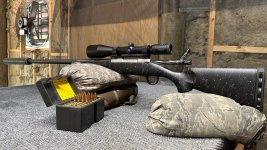
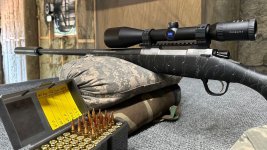
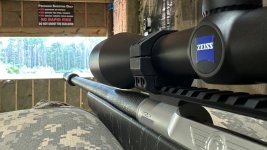
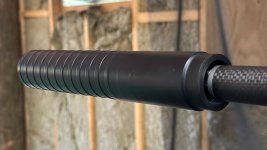
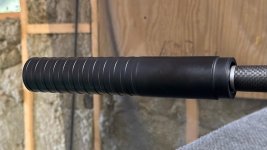
So far still working on load development, so no results to post yet. I did notice that Christensen really cuts the chamber throats short on these. As a handloader, I’m not a fan. They are seated pretty deep into the case neck, even with Berger 168 VLDs. There’s plenty of room left in the magazine well, so I wish they would cut them a little bit longer (more normal). At almost 2 grains less than book load max, I’m already seeing pressure signs and ejector swipes.
On top sits an older Zeiss Conquest MC 3-12x56 30mm FFP scope. I’ve had this scope for nearly 15 years. It’s been on quite a few different rifles. It’s sitting in a set of Seekins Precision rings, on an EGW HD base.





New video comparing my Dead Air Sandman-S & Nomad-LT with my Otter Creek Labs Hydrogen-S on my new 10" .300 BLK build. I'm using a non-magnified EOTech 512 with the A65 "donut of death" reticle to holdover and hit a 10" steel gong at 200 yards.
Last edited:
Went and put 25 rounds (first round) of load development for the new CA Ridgeline .280 Ackley. Discovered that my Zeiss 3-12x56 FFP has too heavy of a duplex reticle for load development, where it’s covering up the whole bullseye, and I can’t really zero-in with precision. So, I came home and removed it, and swapped on a spare Vortex Viper HST 6-24x50 VMR-1 that I had sitting around on a rifle I don’t shoot. Once load development is done, I’ll swap the Zeiss back on there for hunting. 
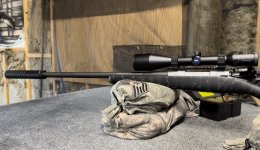
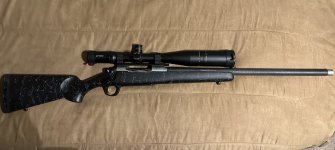
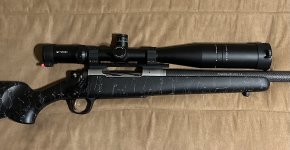



Picking up on an old thread, but if anyone is still looking for OCL suppressors, we are liquidating our inventory, lots of good deals.
Otter Creek Suppressors at Chrarlie's
Many have asked us, "Why?" It really comes down to personalities and business relationships. From what I can tell, the suppressors are above average. The Why behind the Why is not important, and not suitable for prime time. Business to business dealings should not be public. Just want to move OCL out of our building and if you like their products, we will help each other out.
Otter Creek Suppressors at Chrarlie's
Many have asked us, "Why?" It really comes down to personalities and business relationships. From what I can tell, the suppressors are above average. The Why behind the Why is not important, and not suitable for prime time. Business to business dealings should not be public. Just want to move OCL out of our building and if you like their products, we will help each other out.
I noticed the video of mine that y’all were using on your page for the Hydrogen-S on the 6.5 Grendel got flagged and taken down by YouTube because someone randomly reported it to YouTube that I had a link to a different dealer in the description box…Picking up on an old thread, but if anyone is still looking for OCL suppressors, we are liquidating our inventory, lots of good deals.
Otter Creek Suppressors at Chrarlie's
Many have asked us, "Why?" It really comes down to personalities and business relationships. From what I can tell, the suppressors are above average. The Why behind the Why is not important, and not suitable for prime time. Business to business dealings should not be public. Just want to move OCL out of our building and if you like their products, we will help each other out.
All of them had (all links have since been removed) the same link, but only that one got flagged…
Last edited:
1,700+ views gone… Plus, YouTube started vehemently throttling my content and reach after that. Even harder than they were before. 
New video is up comparing the Dead Air Nomad-LT and the Otter Creek Labs Hydrogen-L on my new Christensen Arms Ridgeline .280 Ackley Improved.
New video is up of my new Ruger American Ranch 16" .300 Blackout bolt-action rifle shooting my handload 220 subs, comparing my Dead Air Sandman-S MIL Contract to my Otter Creek Labs Hydrogen-S.
Found good info on the Hydrogen here, but wanted to add that 3M Peltor electronic earplugs like the EEP 100, TEP100/200 are the bees knees. 33 dB NRR with Skull screws but has almost full situational awareness. I can hear background conversations at the machine gun range, twigs snapping in the woods, etc... there's zero reason to not wear any hearing protection. Even Special Operators are running electronic hearing pro with communications adapters for their radios.
They're your ears, and you're a grown adult...Do what you want. Wear hearing protection...Sure. Don't...Cool. I honestly don't care what people do with their own bodies.Found good info on the Hydrogen here, but wanted to add that 3M Peltor electronic earplugs like the EEP 100, TEP100/200 are the bees knees. 33 dB NRR with Skull screws but has almost full situational awareness. I can hear background conversations at the machine gun range, twigs snapping in the woods, etc... there's zero reason to not wear any hearing protection. Even Special Operators are running electronic hearing pro with communications adapters for their radios.
They're your ears, and you're a grown adult...Do what you want. Wear hearing protection...Sure. Don't...Cool. I honestly don't care what people do with their own bodies.
I wasn't aiming it at you or anyone in particular. I'm just saying modern electronic hearing protection is so good that its almost like not wearing hearing protection but with 33 dB NRR (good earplugs). We spend tons of money on rifles, suppressors, and scopes, so why not on cool high speed low drag hearing protection? I'm still waiting to get my hands on the TEP-300s in Coyote Brown. The EEP-100s are great but are in fluorescent green.
Similar threads
- Replies
- 15
- Views
- 3K
- Replies
- 36
- Views
- 16K
- Replies
- 4
- Views
- 2K
- Replies
- 4
- Views
- 1K

